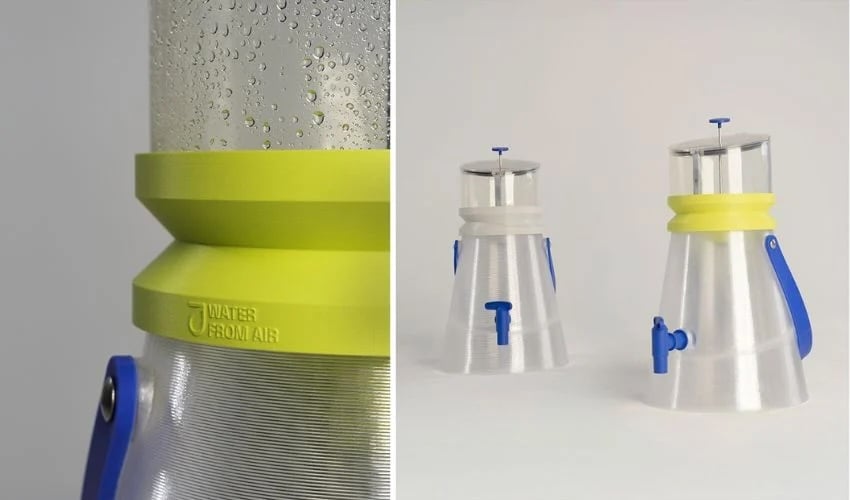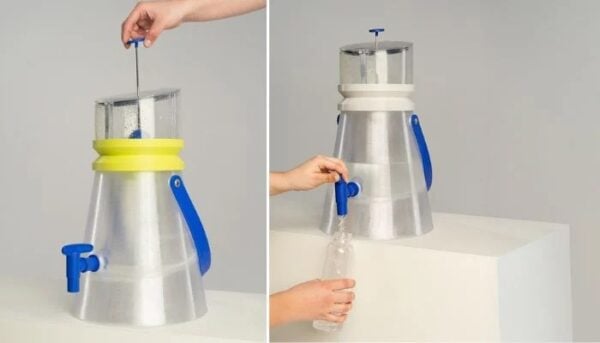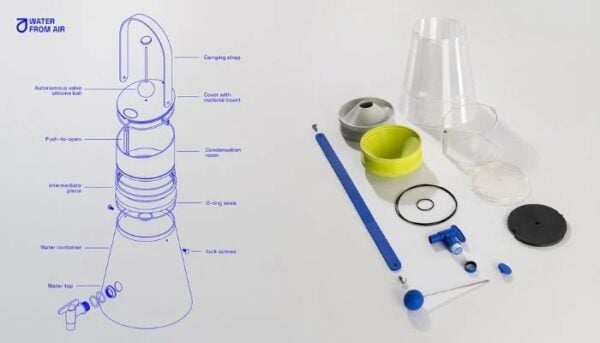A New 3D Printed Device is Capable of Transforming Air into Drinking Water

Imagine a device capable of extracting drinking water from the atmosphere, providing a feasible remedy to the global water crisis we are experiencing. Indeed, more than 2 billion people worldwide do not have access to clean drinking water, and 14 people die every day from diseases caused by this lack. This is the ambition of Louisa Graupe and Julika Schwarz with their “Water from Air” solution. It is a mobile device that can collect water from the air and transform it into drinking water, all thanks to the concept of metal-organic networks, which uses materials made of metal ions that act like a sponge. The reason we’re talking about this new device is that the casing for this innovative system has been 3D printed, resulting in a custom-made, modular component.
The process of recovering water from the atmosphere is not new, but it has given rise to complex and technical systems. Louisa and Julika want to develop a more accessible concept that can be used in any home, by anyone. They explain their vision: “Water from Air is designed as a mobile water producer and storage unit that can be used flexibly in private households, regardless of geographical and social circumstances – a practical solution and application option for people all over the world. The concept initially enables the production of 6 litres of drinking water per day and is scalable for the future. The prototype was largely produced using 3D printing.”

The Water from Air Device
How 3D Printing is Used Within the Device
Water from Air is divided into several components, many of which were 3D printed using different processes and materials. Let’s start with the water tank, the part found at the base of the device. Here, fused deposition modeling was used with transparent PETG. Above the tank is an intermediate part that was also designed using an FDM machine and PETG. Finally, the upper part with the lid was produced using an SLA 3D printer; it was 3D printed in four different parts, which then required post-processing steps.
Additive manufacturing was chosen as the prototyping method because it allows for the designs to be modified and custom parts to be produced. The aim is to quickly manufacture several devices so that they can be used anywhere in the world. The overall goal may be to offer these 3D files for download so as to enable on-demand production directly at home.
How the Device Operates
But how does the Water from Air solution work? As explained in the introduction, Louisa and Julika relied on Metal-Organic Frameworks—materials that offer high absorption capacity and porosity. Specifically, they are capable of capturing water molecules from the air and releasing them in the form of fresh water. They therefore inserted these materials into the lid of the Water from Air device. The lid must remain open for an hour in order to draw water from the air. Thanks to their properties, they absorb very few pollutants, eliminating the need for a filter.

The different components of the system.
Once the hour has passed, the lid is closed so that the air inside heats up, creating condensation. This distillation process is completely natural, producing drinking water. This process also takes one hour. Finally, the ball valve can be opened to drain the water. A tap allows for quick and easy use. The device is capable of producing 6 liters of water per day, and has a handle for easy transport. The goal is to be able to scale up the solution to address larger needs, such as providing drinking water to an entire community. In the meantime, you can learn more about this project by clicking HERE.
What do you think of the Water from Air device? Let us know in a comment below or on our LinkedIn or Facebook pages! Plus, don’t forget to sign up for our free weekly Newsletter to get the latest 3D printing news straight to your inbox. You can also find all our videos on our YouTube channel.
*All Photo Credits: Louisa Graupe /Julika Schwarz







